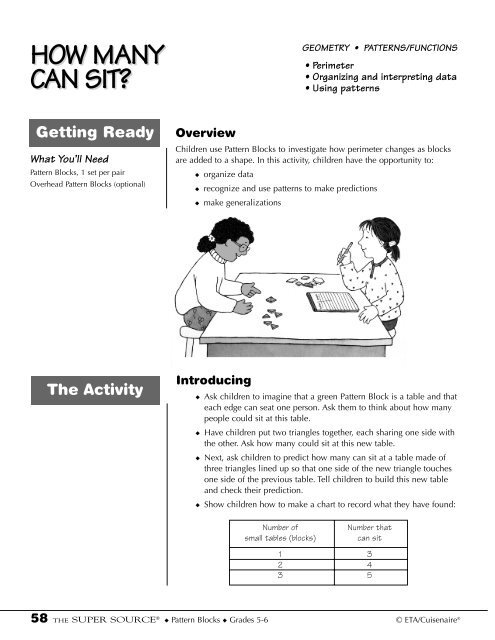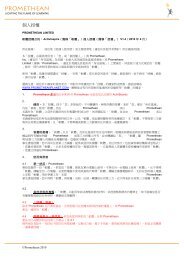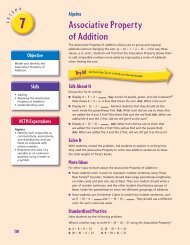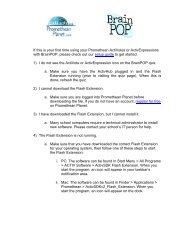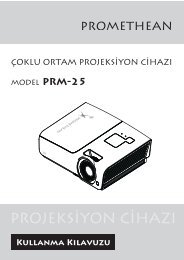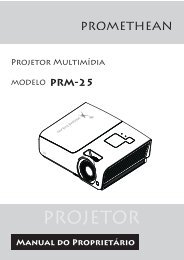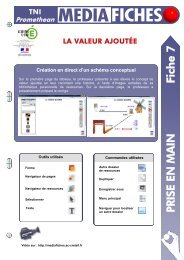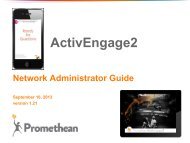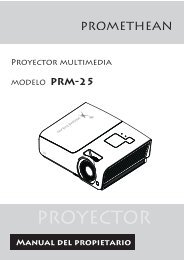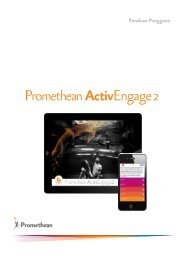Pattern Blocks â How Many Can Sit? - Promethean Planet
Pattern Blocks â How Many Can Sit? - Promethean Planet
Pattern Blocks â How Many Can Sit? - Promethean Planet
Create successful ePaper yourself
Turn your PDF publications into a flip-book with our unique Google optimized e-Paper software.
Teacher TalkWhere’s the Mathematics?As children build new tables and count their sides, they begin to see howthe growth of the perimeter of a shape is related to the way the shape growsgeometrically. For example, as they join together triangles to make tables,children find that the perimeter increases by 1 unit each time a triangle isconnected to the existing shape. This may surprise children who may thinkthat the perimeter should increase by 3 units since a triangle has three sides.Other children may think the perimeter should increase by 2 units since oneof the sides of the new triangle will end up interior to the new shape. Asthey continue to “grow” the shape, children may come to see that each newtriangle takes away an existing seat at the table and adds 2 more, resultingin an increase of only 1 seat.new seat new seatlost seatnew seatJust as each added triangle makes room for one more person at the table,each added square makes room for two more people, each added pentagonmakes room for three more people, and each added hexagon makes roomfor four more people.lost seatnew seatnew seatnew seatlost seatnew seatnew seatnew seatnew seatnew seatlost seatnew seatnew seatnew seatChildren may use different methods for finding the number of people thatcan sit at the tables made from 100 single tables. Some children may basetheir predictions on patterns they see in the numbers in their chart. They60 THE SUPER SOURCE ® ◆ <strong>Pattern</strong> <strong>Blocks</strong> ◆ Grades 5-6 © ETA/Cuisenaire ®
Extending the Activity1. Have children repeat the activity using decagons formed by adjoiningtwo hexagons. Ask them to make tables in which the decagons share oneside, share two sides, and share three sides. Have them record theirresults and look for patterns.may continue the patterns, by adding the common difference to find the100th term in each sequence, or they may be able to make a connectionbetween the number of tables used and the number of seats that are created.For example, in studying the chart below, children may notice that the numberof people that can sit at a table made from pentagons is 3 times thenumber of pentagons plus 2. From there, they can figure out how many peoplecan sit at a table made from 100 pentagons simply by applyingthis formula.Number ofNumber of peoplepentagons (tables)who can sit1 52 83 114 145 176 207 23Other children may make predictions based on patterns they see in the actualformation of the <strong>Pattern</strong> Block “tables.” For example, some children maynotice that when squares are joined in straight lines to make tables, eachsquare in the arrangement provides a seat for two people (one on either sideof the table), with the squares at the end providing two additional seats (atthe heads of the table). These children may realize that they can figure outthe number of seats for any table constructed this way by multiplying 2times the number of squares and adding 2.head1 2 3 4 5 6 7head7 squares(7 x 2) + 2 = 16It is likely that not all children will be able to generalize their findings.<strong>How</strong>ever, it is valuable for children to share their insights and strategieswith each other. In doing so, children discover different ways of looking atproblems and interpreting results.© ETA/Cuisenaire ® HOW MANY CAN SIT? ◆ <strong>Pattern</strong> <strong>Blocks</strong> ◆ Grades 5-6 61
This hands-on lesson was provided by ETA/Cuisenaire®. Hands-on materials helpstudents learn faster! They help students deepen their understanding of importantmathematical concepts and foster the transition of student understanding from concrete torepresentational to abstract.FAQQ: Where can I find and buy the manipulatives identified in the lesson for my studentsto use?A: Go to www.etacuisenaire.com. Type the name of the manipulative in the Search boxat the top of the ETA Web page.Q: <strong>Can</strong> I use virtual manipulatives to teach the lesson?A: Yes! We recommend you use ETA/Cuisenaire certified manipulatives available from<strong>Promethean</strong>® <strong>Planet</strong> or from www.etacuisenaire.com. If possible, use the virtualmanipulatives for whole-class instruction and the physical manipulatives for small groupand independent student work.Q: Where can I get more lessons like this one?A: Two great resources for lessons focused on hands-on materials available fromETA/Cuisenaire are The Super Source® books and Hands-On Standards®, DeluxeEdition.Q: What is the difference between lessons in The Super Source books and Hands-OnStandards, Deluxe Edition?A: Hands-On Standards, Deluxe Edition provides scripting and support for the teacherwho is beginning to introduce the use of manipulatives into the math classroom. TheSuper Source provides a wide range of topics and lessons that can be taught with aspecific manipulative.


